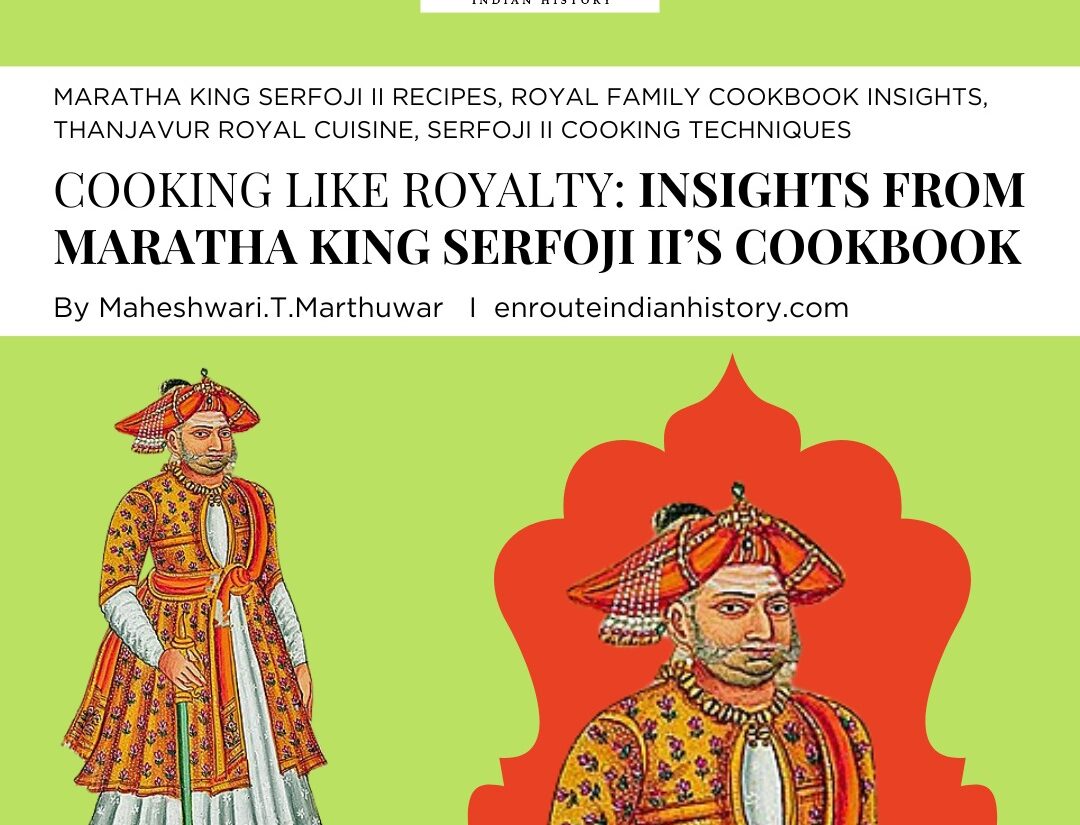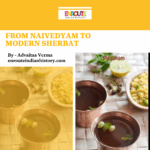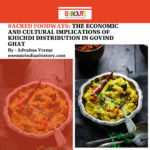Cooking Like Royalty: Insights from Maratha King Serfoji IIs Cookbook
- EIH User
- June 5, 2024

Tucked away in the annals of culinary history lies a treasure trove of flavors and traditions: the ‘Sarabendra Pakashastra,’ a cookbook compiled under the patronage of Serfoji II, the enlightened Maratha King of Thanjavur. This manuscript, a testament to the rich gastronomic heritage of the Thanjavur court, offers a fascinating window into the culinary practices of the early 19th century. Beyond its historical significance, the ‘Sarabendra Pakashastra’ is a delectable journey through an array of recipes, showcasing the refined palate and culinary prowess of the era. From intricate sweets and savory dishes to exotic spices and rare ingredients, the cookbook presents a captivating tapestry of tastes and techniques, inviting us to experience the culinary opulence of the Maratha court firsthand. This article delves into the ‘Sarabendra Pakashastra,’ exploring its historical context, the remarkable personality of King Serfoji II, the unique blend of culinary influences, and the intriguing recipes that offer a glimpse into the heart of a bygone era. Join us as we unravel the secrets of this royal cookbook and savor the legacy of a culinary masterpiece that continues to tantalize our taste buds even centuries later.

Sarabendra Pakashastra Cookbook
The concept of dining like royalty encompasses more than just the food itself; it involves a combination of factors that elevate the dining experience to a regal level. This includes grand portion sizes, the use of silver or gold cutlery, and the possibility of a performance to accompany the meal, creating an atmosphere of luxury and extravagance. Sarabendra Pakashastra, a cookbook originating from the royal kitchens of Maratha King Serfoji II of Thanjavur, offers a unique opportunity to partake in a culinary journey fit for a king. This cookbook provides a glimpse into the opulent and refined tastes of the royal court, allowing modern-day food enthusiasts to experience a taste of history and indulge in dishes that were once reserved for royalty.

Maratha King Serfoji II of Thanjavur
The legacy of Maratha rule in Thanjavur, particularly during the reign of Serfoji II, is characterized by a blend of cultural, artistic, and culinary influences. Serfoji II’s patronage of literature, technology, and science extended to the realm of food, where he introduced European recipes to his kitchen, further enriching the culinary traditions of the royal court. Through Sarabendra Pakashastra, individuals can explore the intersection of history and gastronomy, immersing themselves in the flavors and customs of a bygone era. Raja Serfoji, known for his refined taste in food, had a team of scribes dedicated to transcribing the recipes and notes of his palace chefs in the ancient Modi script used for Marathi language. These manuscripts not only listed the names, salaries, and specialties of each cook in his service, but also meticulously detailed the royal household ceremonies, festivals, and the dishes prepared during these occasions. Additionally, the Raja had a collection of English cookery books, although the recipes for sweets and savory snacks made by his master sweet maker were not included in the documents. The extensive collection of over five hundred Modi records, which encompassed all these culinary details, is now preserved at the Saraswathi Mahal library. Among these records, Sarbendra Pakashastra is a compilation based on just two of the Modi documents. Due to the limited number of individuals proficient in the Modi script, there are still numerous Modi documents awaiting translation and interpretation at the library.
Within the pages of this publication authored by A Krishnaswamy Raje Mahadik, a scion of the former Tanjore royal lineage, readers will uncover a collection of culinary formulas extracted from ancient manuscripts safeguarded within the confines of the Sarasvati Mahal library, which was established by Serfoji II in Thanjavur. It is believed that these recipes were transcribed based on the verbal instructions of a certain ‘Narayana Ayya’ and ‘Butler Venkataswamy’, who were employed in the royal kitchen during the year 1825.
The current iteration of this culinary compendium represents the third edition of the cookbook. Originally brought to light in 1988 by the Sarasvati Mahal Library, the primary objective behind its publication was to safeguard and popularize the traditional Thanjavur-Maratha gastronomy. While the flavors of this cuisine are not entirely foreign to the denizens of South India, owing to the prevalence of numerous military canteens, the gradual disappearance of these establishments has prompted the necessity for this book to serve as a repository of culinary knowledge.
In the words of Pratap Sinh Serfoji Raje Bhosale, the sixth in line of descent from Serfoji II, “This cookbook stands as a testament to the rich culinary heritage of Thanjavur-Maratha cuisine. Its publication aims to ensure that the legacy of these time-honored recipes endures, especially in light of the diminishing presence of traditional eateries in the region. As a custodian of this culinary legacy, it is my hope that this book will not only preserve the flavors of the past but also inspire future generations to cherish and uphold our gastronomic traditions.”
The book showcases a wide range of dishes that are skillfully paired with various sauces, sambars, rice varieties, jellies, and meat preparations, with a particular emphasis on mutton. Additionally, it includes recipes for preserving items such as pickles, podis, and vadagams. These traditional recipes hold great significance in our families and are often prepared during festive occasions. For instance, during Diwali, we prepare Sunti, a delectable mutton meatball similar to the Tamil kola urundai. Similarly, for Pongal or Sankranti, we celebrate the harvest season by relishing Khendata, a flavorful curry made with mixed vegetables and dal. Pratap, an expert in these culinary traditions, highlights the enduring relevance of these recipes in our lives.
The pandemic has played a significant role in reviving the popularity of these recipes, as people have shown a keen interest in rediscovering long-forgotten family culinary treasures. This renewed enthusiasm has led to a surge in demand for copies of the previous two editions of the book. Notably, hotels across the country have started organizing Thanjavur-Maratha food festivals, where the go-to reference for authentic recipes is the renowned book, Sarabendra Pakashastra. Pratap proudly mentions that his mother’s guidance has been instrumental in these culinary events.

Sunti – mutton balls
Despite being in its third edition, the book is not without its flaws. It is plagued by language errors that can be quite distracting for readers. Furthermore, the book’s weak points of reference become apparent, as measurements are provided in terms of handfuls and tolas, an ancient Indian unit of measurement equivalent to 180 grains. This unconventional approach may lead to potential discrepancies in the preparation of the dishes. However, for those willing to embark on a journey of trial and error, the book offers tantalizing recipes such as Kesari Maas, Blood cubes, Mutton Jelly, and Sugar rice that are worth exploring.

Vegetable Khendata

A vessel used in Raja Serfoji II’s kitchen
Raja Serfoji’s vegetarian kitchen, also known as the Brahmin kitchen, was renowned for its unique Thanjavur style dishes, showcasing a blend of traditional flavors and ingredients. The recipes in Sarabhendra Pakasasthram provide insight into the culinary practices of that era, with ingredient measurements based on the weight and measurement system prevalent in Thanjavur during those times. Tola, palam, and padi were commonly used measures, with one tola approximately equivalent to 2.9 grams, twelve tolas making a palam, and one padi equaling 750 grams. Some recipes also incorporated pounds as a unit of measurement. The vegetarian dishes featured in the cookbook highlighted the use of staple ingredients in South Indian cuisine, such as coconut and tamarind, along with a variety of vegetables including eggplant, snake gourd, drumstick beans (Moringa), raw plantains, jackfruit, okra, and cucumber. The emphasis on fresh produce and traditional cooking methods added to the authenticity of the dishes prepared in Raja Serfoji’s kitchen, reflecting the rich culinary heritage of the region. Sarabhendra Pakasasthram showcased a wide array of vegetarian recipes, starting with detailed instructions for rice dishes and including a diverse range of preparations like sauces, poriyals, koottu, curries, kolambu, sambar, and sandage. The simplicity of the recipes, coupled with the use of minimal spices, highlighted the focus on flavor and quality ingredients. The large quantities of ingredients required in these recipes were indicative of the scale of food production in the palace kitchen, catering to the royal household’s needs. While the rice section featured traditional South Indian recipes like tamarind rice, yogurt rice, sesame rice, and kichadi, the curries section included dishes like poricha kulambu, sambar, and various koottu preparations. Notably, the absence of sweet and dessert recipes in the cookbook hinted at a preference for savory dishes in Raja Serfoji’s vegetarian kitchen. The limited inclusion of sambar recipes, with only one variation for neem flower sambar, added to the intrigue surrounding the culinary practices of the Maratha kings and their influence on South Indian cuisine.

Dining in Colonial India Photo Credit William Henry Jackson
The fascination with British cuisine led to the establishment of a separate English kitchen within his palace. In order to enhance the culinary skills of his cooks, he sent them to train at the military kitchens located at British Fort St. George in Madras. The result of this training was a unique blend of Indo Anglo flavors, which can be best described as a fusion cuisine. One of the notable outcomes of this fusion was the creation of piccalillis, where traditional chutney ingredients were combined with vinegar. Another popular dish that emerged from this culinary exchange was kedgeree, a rice porridge that featured smoked fish. Additionally, the British incarnation of rasam, known as mulligatawny soup, also originated from this Indo Anglo fusion. According to David Burton’s book “Raj at the Table,” cooks in the country houses of the southern gentry during the 1700s began experimenting with imitation pickled mangoes using ingredients such as marrows, cucumbers, melons, lemons, and peaches.
In addition to its many recipes, the Sarabendra Pakashastra is also a valuable cultural artifact, providing insights into the daily life and customs of the Maratha court. The cookbook includes detailed instructions on how to set a proper table, how to serve guests, and how to prepare for special occasions and festivals. Today, the Sarabendra Pakashastra is cherished by food enthusiasts and historians alike, offering a rare glimpse into the rich culinary traditions of the Maratha kingdom of Thanjavur. While many of the recipes may seem daunting to the modern cook, they serve as a reminder of the artistry and craftsmanship that went into creating the dishes of the past. In conclusion, the Sarabendra Pakashastra is a true culinary masterpiece, a testament to the creativity, skill, and cultural heritage of the Maratha people. Whether you are a seasoned cook or simply a lover of good food, this cookbook is sure to inspire and delight.
Reference
Article And Images Sources
- Achaya, K.T. Indian Food: A Historical Companion. Oxford University Press 1994.
- Ananyaa Desikan, Notes from the royal table of king Serfoji II of Thanjavur, The Hindu News Article, 25th January 2024.
- Burton, David The Raj at the Table – A culinary History of British India London; Boston: Faber, 1993.
- Revised edition of Sarabendra Paka Sastra elicits good response, The Hindu Bureau, 9th October 2023.
- Sarabhendra Pakasasthram – Part I, Peppertrail by Ammini Ramachandran, Article Access On 31st May 2024.
- Prabalik M. Borah, Tastefully royal, The Hindu News Article, 11th October 2019.

















